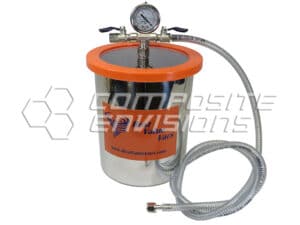Why Remove Bubbles From Your Resin?
Removing bubbles ensures optimal adhesive performance by providing a good continuous bond and improves the appearance of the finished part.
Air entrapment is an inevitable occurrence when any product, regardless of its viscosity, is mixed. This tip discusses two techniques for removing and reducing this entrapped air. Air can become entrapped within a hand mix of material in an open container. The following are a couple simple ways to remove bubbles from epoxy before applying it to your parts: Vacuum Degas, and Heat.

Mixing:
The proper mixing technique used minimizes the introduction of air, greatly reducing the effort needed to remove bubbles.
Using the proper mixing bit is important in getting bubble-free resin.
Check out our Resin Mixing Bit. This bit will give you a very nice mix while minimizing the addition of air bubbles. Proper technique in mixing with a bit like this is to hold the bit as straight up vertical as possible. This will create a nice vortex and mix the products well, little to no air will be drawn in. Mixing while the bit is at an angle can introduce air into the mixture. If you have a drill press available, using it with this bit would produce the best results.
Vacuum Degas:

Vacuum degassing involves actual removal of the air surrounding the epoxy by allowing the air that is trapped within the epoxy to easily escape. In order to accomplish this, the epoxy should be placed into a container that has at least five times as much volume capacity as the epoxy itself. This is due to the “rise” in the volume of epoxy once the material is subjected to the vacuum. The vacuum should be created with a pump that can pull at least 29 inches of Hg quickly. The key is to hold the vacuum for as short a period of time as possible without pulling too much vacuum. An indication of this is a “rolling boil” which will have the opposite affect and actually adds bubbles to the epoxy.
Vibration can also assist in facilitating the bubbles while pulling the vacuum.
This method is used for epoxy that is in an open container only.
Heat:
Heat is a simple and efficient way to remove bubbles from epoxy. The key to this technique is to keep the product in a wide container that has large amounts of epoxy in the width and length, but little in depth. This gives the maximum amount of surface area for the bubbles to escape.
This method is used for epoxy that is in an open container only.
